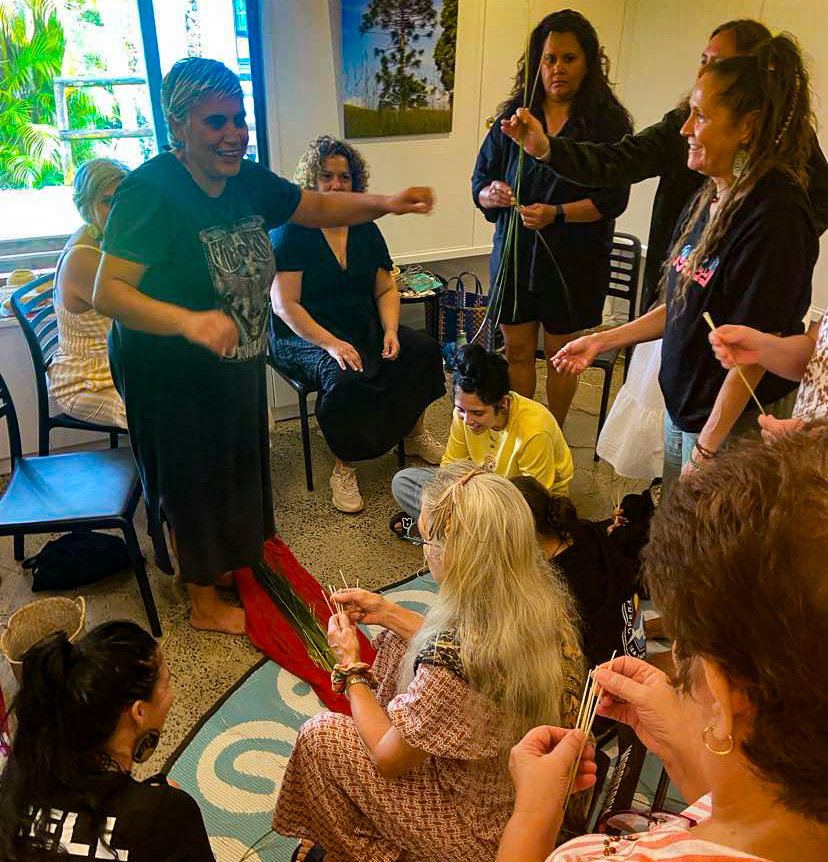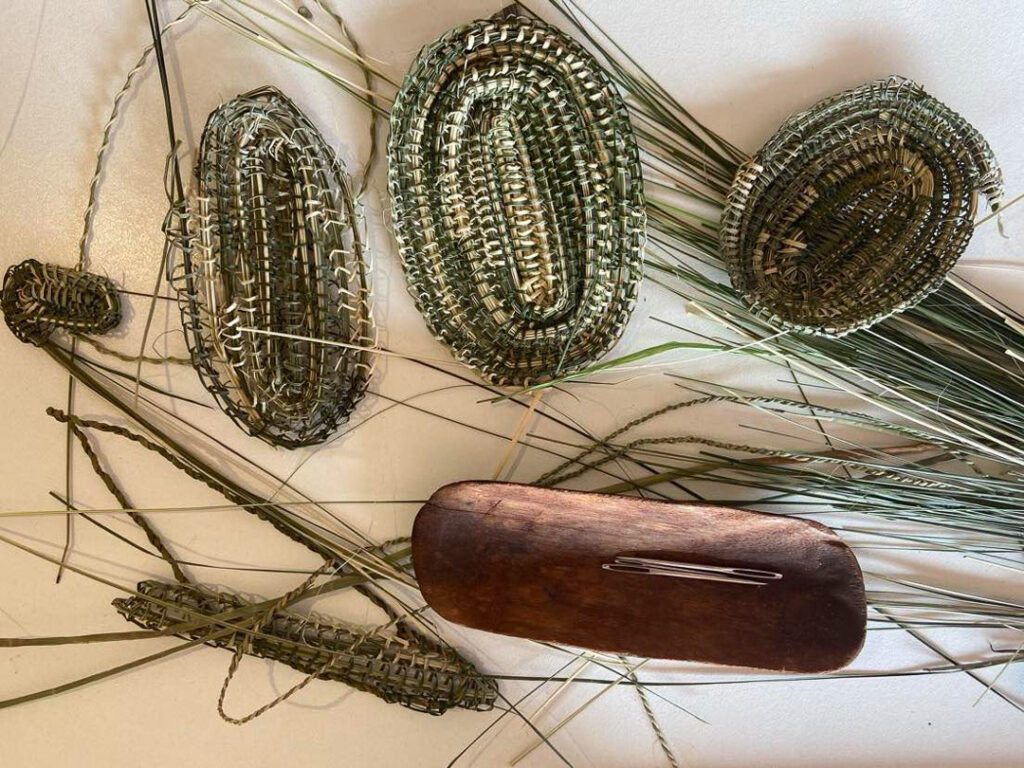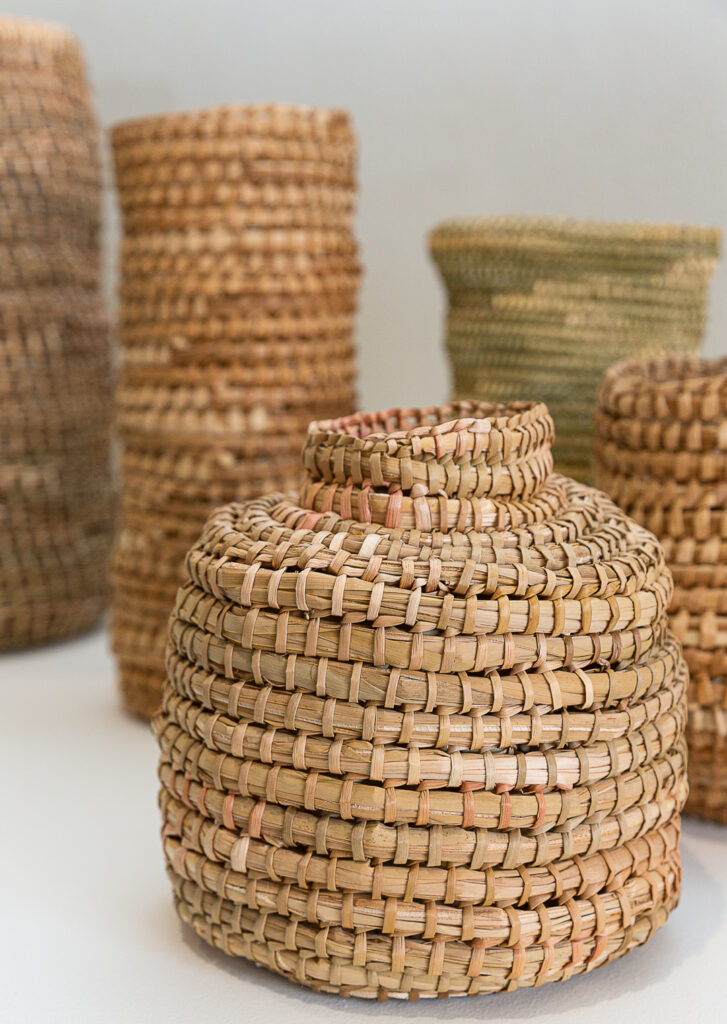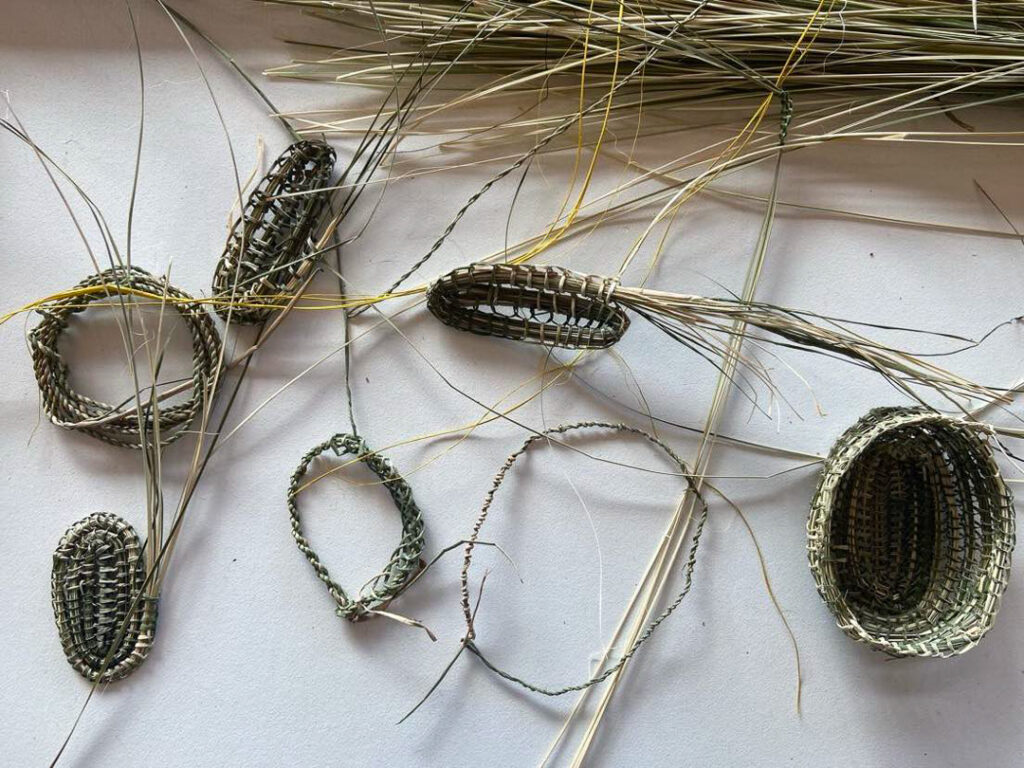
Weaving by Bianca Bond, Kylie Caldwell and Sonja Carmichael with bonyi at Munimba-ja; photo: Freja Carmichael
Freja Carmichael reflects on a gathering of weavers at Munimba-ja to celebrate the bonyi nut harvest.
I would like to acknowledge Aunty Bev Hand, Libby Harward, Bianca Bond, Kylie Caldwell and my mother Sonja Carmichael’s collaboration on Bonyi: weaving culture, Munimba-ja in February 2024.
In weaving together, a space is created that is alive with First Nations connections, sharing, and cultural ways. Often referred to as a “weaving circle”, when kin, community and connections come together through weaving, these spaces are a significant time of gathering and relating with the knowledges, practices and stories grounded in Ancestral past and Country. As a Ngugi woman, from Quandamooka, I have joined weaving circles on Country, in family and community spaces, art centres, exhibitions, Indigenous art fairs and more. While varying in formats and guided by the cultural knowledges across Country, these spaces embody weaving practices and nurture living culture as forever evolving and continuing.
The recent weaving gathering Bonyi: weaving culture held at Munimba-ja, Maleny on Jinibara and neighbouring Kabi Kabi / Gubbi Gubbi Country represents a time of how we come together. This celebration honoured the ways in which Country guides and inspires weaving practices today. The bonyi season in present-day southeast Queensland was the calling for this gathering. The bonyi/bunya tree (Araucaria bidwillii) produces large cones which contain individual edible nuts. Across time and generations, the bountiful nuts are a significant source of sustenance and deep cultural and spiritual connection for custodians of bonyi-rich Country and visiting First Nation groups. The seasonal ripening, abundance and harvesting of bonyi interconnect with Ancestral times of travelling, hosting, gathering, ceremony and cultural making. Coinciding with this time of interconnectivity, Bonyi: weaving culture brought together First Nations weavers, community and cross-cultural knowledges and practices which have been nurtured and transformed over time and generations.
We came together for a weekend in late February when bonyi season was nearing the end of another cycle. I worked closely with Kabi Kabi Elder, Aunty “Bev” Beverly Hand and Munimba-ja director and Quandamooka artist, Libby Harward to organise the Bonyi: weaving culture gathering, which also occurred alongside an exhibition curated by Munimba-ja. Aunty Bev hosts an annual Bunya Dreaming event on the Sunshine Coast. This is an important community gathering for sharing the spiritual, cultural and Ancestral resonance of the bonyi/bunya and creating a time of coming together in new ways.
Bonyi: weaving culture is also linked to the bunya story by gathering through the rhythms of Country. The program involved a public weaving circle and a First Nations mob weaving circle. These spaces of sharing were led by local Kabi Kabi woman descending from the Da’la peoples, Bianca Bond and visiting weavers from neighbouring Country, my mother, Ngugi woman from Quandamooka, Sonja Carmichael, and Bundjalung woman Kylie Caldwell. Sonja travelled from Minjerribah/ Terrangeri (North Stradbroke Island) across the saltwater bay and journeying up to the mountains along the old pathways. Further south, Kylie also followed Ancestral journeys from Bundjalung to the north.
Prior to Bonyi: weaving culture, Bianca, Sonja and Kylie collected and prepared weaving materials, enacting cultural knowledges and practices of Country. Along with materials, they each travelled with examples of their work: intricately woven string bags and baskets created with weaving reeds and other natural materials. The variations in bags and baskets shared similar materials and techniques, whilst also carrying the stories of cultural specificity and the journeys in reconnecting with Ancestral weaving knowledges today.
Munimba-ja is an art centre, gallery, studio, cultural space, community meeting hub and on this occasion (and for many other community events) it hosted the weaving circles, where weaving and creating also incited a time of sharing, yarning, listening and feasting together. Many of the stories and practices shared were grounded in widespread regeneration of local weaving knowledges which was a testament to the women continuing and leading these practices today.
Such as Bianca Bond, who belongs to a family of weavers, artists, dancers and Ancestors that guide her practices and her role in continuity of culture. Bianca weaves string and looped bags which commence with her careful harvesting and sustainable collection of reeds that have been nurtured by Country. Over the past decade, my mother, Sonja, has been researching museum collections and listening to living memory and stories to continue Ancestral techniques of weaving ungaire (reeds) into looped and knotted diagonal bags, that we know today as gulayi. Kylie has also been regenerating Bundjalung weaving knowledge and practice by working collaboratively with a local group of women in Casino, the Wake Up time weaving group.
- Coil and string making woven with lomandra and reeds during Bonyi: weaving culture. Image: Lexie Abel
- Kylie Caldwell, woven baskets with Buchie Rush (wetland reed). Photo Kate Holmes
- Coil and string making woven with lomandra and reeds during Bonyi: weaving culture. Image: Lexie Abel
Despite the stormy and wet weather that had persisted through most of the recent summer, the Bonyi: weaving culture mob weaving circle was a large turnout of community, as an intergenerational and cross-cultural gathering of family, cultural groups and kinship connections. The mob weaving circle created a relational space for all experiences to weave together. Some weavers brought along examples of their weavings which showed different techniques, forms and working with fibres from Country and new materials. In this space, there was also the guidance and teachings of leading weavers in the group.
Along with being an important cultural and physical space for the sharing of culture, ideas and experiences between First Nations people, weaving circles are also a site for sharing culture broadly, but on terms that relate to Country and embedded in cultural ways. This includes demonstrating weaving with materials collected from Country in the public weaving circle. Kylie Caldwell expressed the relationality of weaving: “plant fibres used in weaving also have a relationship with all living beings, animal kin, environment and Country.” This important reminder of the interconnectivity between weaving, plants and storied places embeds First Nations knowledges and protocols of only taking what is required when weaving with Country.
My favourite part of the weekend was feasting together on freshly cooked and prepared bonyi nuts, while weaving, sharing and connecting. This weekend of Bonyi: weaving culture reflects how a time of weaving together aligned with the story and cultural memory of Ancestral gatherings, harvesting and connecting with Country.
The physical traces of the weaving circles were encouraged to be left behind in the exhibition space at Munimba-ja. This included strands of fibres, string, the starting bases of coiling and other examples of experimenting in techniques and processes. The physical remnants of gathering represented a spirit of inclusivity and coming together that moves beyond the space, demonstrating how culture continues to flow and evolve with us. This celebration of living culture shows the relationality of gathering, weaving, plants, knowledges, Country and everything that is in between.
I would like to acknowledge and thank Aunty Bev Hand, Libby Harward, Bianca Bond, Kylie Caldwell and my mother Sonja Carmichael’s collaboration on Bonyi: weaving culture, Munimba-ja in February 2024.
About Freja Carmichael
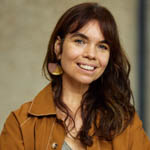 Freja Carmichael is a Ngugi, Quandamooka woman and a curator, writer and PhD candidate with the University of Queensland. Over the past decade, she has worked alongside First Nations artists and communities on exhibitions, programming, research and writing. Her world focuses on celebrating weaving and seasonal practices and creating sites for exchange and collaboration through curatorial approaches. She is currently an Adjunct Research Curator with UQ Art Museum, and in her free time, she loves heading home to Country and being with family.
Freja Carmichael is a Ngugi, Quandamooka woman and a curator, writer and PhD candidate with the University of Queensland. Over the past decade, she has worked alongside First Nations artists and communities on exhibitions, programming, research and writing. Her world focuses on celebrating weaving and seasonal practices and creating sites for exchange and collaboration through curatorial approaches. She is currently an Adjunct Research Curator with UQ Art Museum, and in her free time, she loves heading home to Country and being with family.

